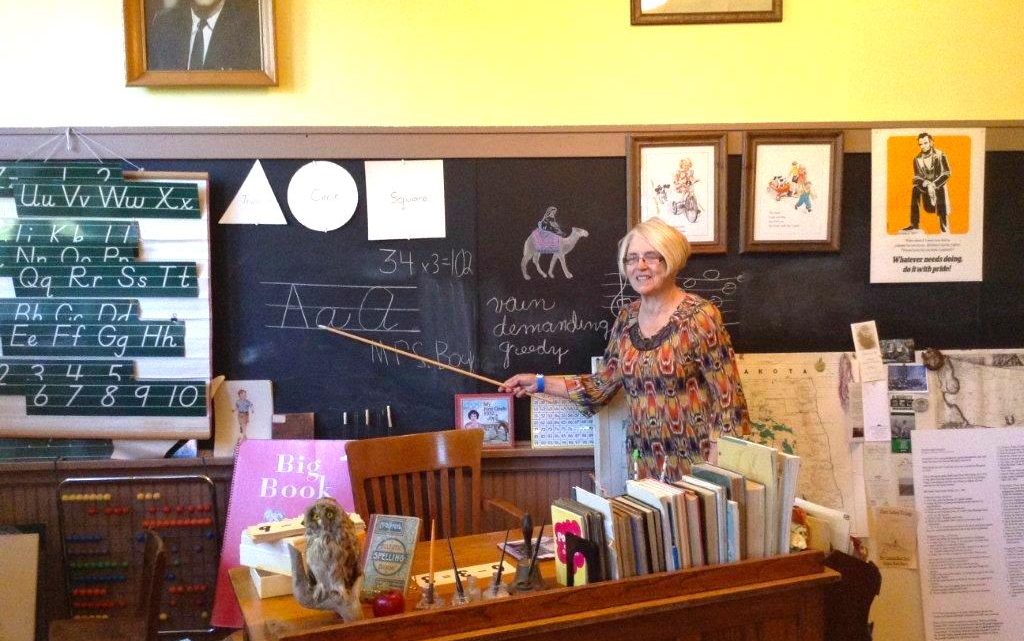Long ago, almost every American child attended classes in a single-room schoolhouse. Today, according to a 2014 CBS news report, only 200 schools in 22 states continue that tradition. The report points out that John Adams taught in a one-room school near Boston in the 1700s, Abraham Lincoln was educated in a one-room school and Henry Ford loved his so much he had it moved to a museum in Michigan.*
Karen Boyko, of Turtle Lake, North Dakota, spent 42 years in the field of education—25 of those in administration. She taught K–6th grade and started an elementary music program in 1968, which continues to this day and for which she was recognized at the time of her retirement.
Boyko attended a one-room school for three years and says she always secretly dreamed of owning her own. Consequently, whenever she traveled Boyko collected memorabilia, which she kept in a grain bin on her farm. “I have the large George Washington bust that was in all country schools, but the Lincoln one is missing. Some things were given to me,” she says. “I created an honor roll of people who have donated things to me. One gentleman said, ‘Karen, this is the first time I have seen my name on an honor roll.’”
Then one spring her school came up for auction. “My husband Roger had said, ‘You are going to have to think about your antiques because we are going to be needing your grain bin this year,’” Boyko explains. “That was when Lake Williams Township Board put the school up for bids. I was so struck by the tin ceiling inside. I knew I had to put in a bid for it.”
But Boyko admits she worried about what she would do if she got the school. She knew it would need to be relocated from its original site to their farm.
In 2002 Boyko purchased the school and hired a house mover to move it. “It took a little to get it refurbished, to make it the one-room school that it once was,” Boyko says. She acquired a potbelly stove and sandblasted and painted it.
The school is now a museum and in 2006 was opened to the public. It is open from the first of June through October every year.
Melted crayons and other history
“Turtle Lake Days, all-school reunions and special-year reunions are a big time in Turtle Lake,” Boyko explains. “One of the classes had a 50th class reunion and several were there who had attended the school. They told stories of their years. One was about the coal stove. They would have to bank the stove using coal to hold the heat overnight. The students whose desks were in close proximity to the stove would find their crayons melted in the morning.”
Boyko states that the school’s furnishings bring back many memories for visitors who have been enrolled in a one-room school. Others come desiring to experience the one-room setting. One sixth-grade class spent the entire day there and enjoyed the games of the country-school era: Kick-the-Can; Annie, Annie Over; and Simon Says.
“The courthouse burned at about the same time the [previous] schoolhouse burned, in 1927,” explains Boyko. “All school records prior to that were lost. My school was built in 1928. I feel so honored to have the records from when my school was opened until it closed in 1959, when the McClean County reorganization took place and they eliminated the country schools, as we knew them. Lake Margaret #3 is my school. I have books from Lake Margaret #3 and Lake Margaret #2.”
Boyko says her school could be on the national record if it had not been moved from its original location. “But I am so glad to have it and be able to share it,” she adds. Boyko also observes that many of our current church schools have a culture much like a one-room school, with the philosophy of working together. “Some of the teachings students get to hear eight times if they continue through eighth grade,” she points out.
When it comes to education, most students who have attended a one-room school consider themselves fortunate, even regarding it an advantage.* Boyko concurs. “I have never heard anything negative about going to a one-room school,” she says. “It provides a top-notch education.”








